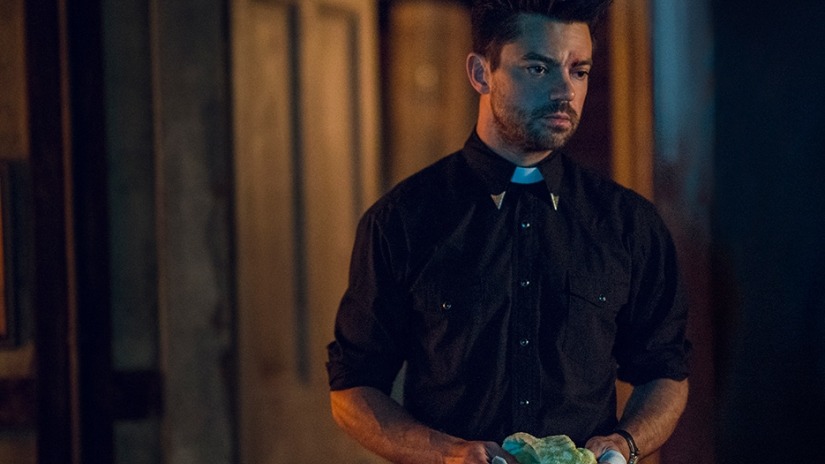This review contains spoilers.
3.1 Angelville
If a character dies in popular media, they’re rarely permanently dead. Perhaps it’s too much exposure to The Walking Dead, in which if you don’t see a character torn to pieces or shot in the head, they’re coming back (one way or another). Maybe it’s too many comic books, in which characters seem to die only to return for interminable prequels, sequels, and reboots (or just come back because the writer likes a specific version of Thor or Wolverine better than another). Either way, a cliffhanger where a character dies doesn’t really do all that much for me, specifically in a show like Preacher in which the power of life or death is handled in a fast-and-loose manner.
The death of Tulip O’Hare is a mere narrative inconvenience to be worked around, given Ruth Negga’s film success and contract status. Tulip might be dead, but death isn’t as permanent as it once was in the Preacherverse. Tulip’s murder by the Grail only serves as a convenient way to get reintroduced to Jesse Custer’s nefarious family members, and to add a little bit more trouble into the Voice-less Jesse’s life.
As far as introductions go, the introduction of Jesse’s cut-throat (or cut-belly) family is effective. You see Miss Marie (Betty Buckley), Jesse’s grandmother, using her voodoo magic on a man to keep him from drinking. It’s then, as the title card establishes, and the L’Angelle family has a busy business of doing magic on the people around them, while also running tours of their decaying plantation home in the swamps of Louisiana. They’re barely making ends meet, then, so when time jumps to the modern day and Jesse comes staggering in cradling Tulip’s corpse, it should come as no surprise that the house is essentially closed up, with fabric draped over the furniture and no one home. Unsurprisingly, Grandma is still alive, and she’s still got TC (Colin Cunningham) and Jody (Jeremy Childs) hanging around to do her bidding, even if the voodoo trade has slowed down considerably.
Tulip serves as a double back-story device. We learn a little bit more about Jesse’s family, and we learn a little bit more about Tulip’s tragic back story as one of the perennial screw-up O’Hare family. Her father is a convict, and her mother is a prostitute who doesn’t seem to be bothered by shoot-outs in the apartment (at least in Purgatory). To Ruth Negga’s credit, it’s funny to watch her interact with her sassy younger self, and it’s interesting to see that she takes being in Purgatory, and reenacting horrible moments in her life, with characteristic blasé. Jesse’s family, despite the bad blood between all of them, welcome him back with somewhat open arms.
I really enjoy the touch Michael Slovis displays behind the camera. He can film a good fist-fight, and he makes the work of the actors, stunt men, and fight choreographers look good, even when it’s not the focus of the action. The initial hallway brawl between Jesse and Cas—tempers finally boiling over regarding Tulip—is wildly fun, especially considering the best bits of it are shot from Miss Marie’s point of view in her wheelchair, her aged hands tapping impatiently as she waits for the boys to finish roughhousing. Ditto the two Jody fights. There’s a ruthless economy to the first one—he demolishes two guys and the rest of the action takes place off-screen while Jesse waits—and a fun indulging in the second, in which we see the guy who taught Jesse everything he knows take his measure. (The climactic shot of Jody picking up, then dropping, a pickup truck’s dual rear axles on Jesse’s head is a great Sam Raimi angle.)
It’s nothing we haven’t seen bits of before, but it establishes the unlucky nature of Tulip and the twisted Southern Gothic nature of Jesse’s upbringing. They’re two wrecked characters from really messed up childhoods, it’s natural that they’d be drawn to one another even before they began their experiences as a couple. Neither of them had much of a parental figure, and the one that they had disappeared early on in their development via getting murdered in front of them. There’s not a tonne of text, but Sam Catlin’s script has subtext built into it. Jesse and Tulip are brought together and belong together because they’re mirrors of one another, right down to the penchant for crime as part of their childhood as grifters and accessories to crimes.
As a way to set up the third season of Preacher, Angelville is effective and throws enough secondary antagonists Jesse’s way to keep him active even when the Grail isn’t terrorising him. His family feud will be problem enough, and colour enough, to power the third season’s more grounded moments and provide more earthly drama. It doesn’t need to be all about the Grail and the search for God; if anything, that’s the sort of big search that needs distraction, and the Saint of Killers is too effective as a killer to be fooled too often.
Read Ron’s review of the season two finale, The End Of The Road, here.
US Correspondent Ron Hogan lives in an old, decrepit house in the South, but it’s not a plantation and it’s definitely not as decrepit as Angelville. Find more by Ron daily at PopFi.

